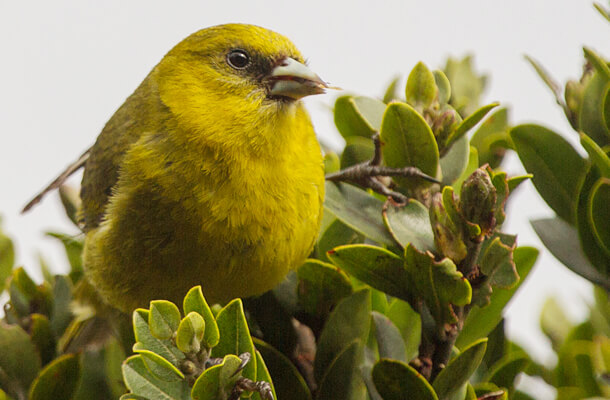ABC and Hawai‘i Groups Ask Congress to Boost Efforts to Help Hawaiian Birds
Contact: Jennifer Howard, Director of Public Relations, 202-888-7472
(Washington, D.C., June 14, 2017) To tackle the worst bird extinction crisis in America, several conservation groups are asking Congress to support a new conservation effort in Hawai‘i that would provide $20 million in funding over the next four years.

The ‘Akeke‘e has lost 98 percent of its population in 15 years. Photo by Robby Kohley
American Bird Conservancy (ABC) and conservation partners in Hawai‘i have sent a letter to the four members of the state's congressional delegation, asking for their support and leadership to enact an aggressive attack on invasive species and avian malaria that are devastating the birds of Hawai‘i. Among the hardest-hit species are ‘Akeke‘e and ‘Akikiki, forest-dwelling honeycreepers.
“The overwhelming majority of the remaining Hawaiian birds are threatened with extinction,” said Chris Farmer, Director of ABC's Hawai‘i Program. “These resources are urgently needed to meet these challenges and expand proven strategies to protect threatened and endangered Hawaiian birds.”
Hawai‘i hosts an incredible diversity of endemic plants and wildlife, with 90 percent of its species found nowhere else in the world. But since humans arrived, more than 90 Hawaiian bird species have become extinct, making it the bird extinction capital of the world.
The majority of those that survive are in serious trouble. More than a quarter of all bird species listed under the U.S. Endangered Species Act are native to Hawai‘i and found nowhere else in the world.
ABC's letter calls for a "dramatic increase" in conservation funding for the state:
"Preventing further extinctions of Hawai‘i's unique birds and plants can be achieved with perseverance, dedication, and additional resources. As a small isolated state, Hawai‘i does not have the resources to safeguard the numerous endangered, endemic species that are invaluable components of national and international biodiversity. It will require a dramatic increase in the funding to support and expand the current network of committed conservation practitioners working on the ground in Hawai‘i."
The funds would be used to support critical conservation work, which includes reclaiming forests from exotic plants and non-native hoofed mammals such as sheep; combating introduced diseases, including avian malaria; removing non-native predators; and stopping the flow of new invasive species to the islands.
“Increased funding would be a lifeline for rapidly declining species such as the ‘Akeke‘e, which has experienced a 98 percent reduction in its population over the last 15 years,” said Lisa Crampton, Project Leader of the Kaua‘i Forest Bird Recovery Project. Only about 945 individuals of this species are left in the wild.
“We know the actions and tactics to bring back the birds, and there are many dedicated conservationists already working incredibly hard – we just need the resources to get the work done,” Farmer said. “Our window to save this unique component of our nation's avifauna is rapidly closing.”
A 2016 ABC report documented the continuing problems for Hawaiian birds listed under the Endangered Species Act. Nine listed Hawaiian bird species are currently in decline.
“The dire situation for Hawaiian endangered birds is in part a result of inadequate spending,” said Steve Holmer, ABC's Vice President for Policy. “Hawaiian birds account for more than one-fourth of all listed birds, but received only 6.7 percent of federal recovery spending for birds in 2014.”
The U.S. Fish and Wildlife Service has been working to increase its conservation efforts in Hawai‘i. In fiscal year 2016, it spent 18.4 percent of its bird recovery funds on Hawaiian birds. Unfortunately, that alone will not be enough to save ‘Akeke‘e and ‘Akikiki and other native birds.
“The population trends for many birds indicate that we still need to do more to reverse current declines,” Holmer said.
###
American Bird Conservancy is dedicated to conserving birds and their habitats throughout the Americas. With an emphasis on achieving results and working in partnership, we take on the greatest problems facing birds today, innovating and building on rapid advancements in science to halt extinctions, protect habitats, eliminate threats, and build capacity for bird conservation.


















































